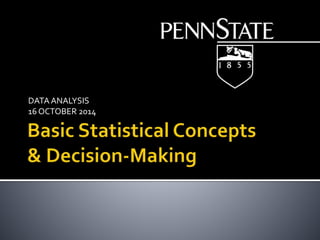
Basic Statistical Concepts & Decision-Making
- 1. DATA ANALYSIS 16 OCTOBER 2014
- 2. TERMS, DEFINITIONS, AND APPROACH
- 3. Population versus sample. Parameter versus statistic. Inference of population parameters from sample statistics.
- 4. Population • Any complete group with at least one characteristic in common. • Not just people. • Might consist of, but not limited to, people, animals, businesses, buildings, motor vehicles, farms, objects, or events. Sample • A group of units selected from a larger group (the population). • Generally selected for study because the population is too large to study in its entirety. • Good samples represent the population.
- 5. Parameter • Information about a population. • Characteristic of a population. • A population value. • The “truth.” Statistic • Information about a sample. • An estimate of a population value.
- 6. Data usually are available from a sample, not a population. That is, sample statistics are available, not population parameters. We wish to infer (or estimate) parameters from statistics. Because data are available from a sample, not the population, error occurs when inferring (or estimating) population parameters from sample statistics. Data analysis techniques help us make decisions under error and uncertainty.
- 8. Are composed of propositions that explain the empirical, observable world. A proposition is an “if–then” statement Are networks showing relationship and causality among propositions. Must have“empirical import.”
- 9. The foundation of theory-building. Statements of testable scientific propositions. The focus for empirical work.
- 10. Examine propositions in theory that require verification. Are specific. Are testable.
- 11. The term "nomological" is derived from Greek and means "lawful.” A nomological network is a"lawful network,” a network of propositions that describe how things work.
- 16. Hypotheses are“tested” Hypotheses are never“proved” Hypotheses only are“rejected” Theories are built and verified by testing hypotheses
- 17. Greek letters used to designate parameters. Letters of English alphabet used to signify statistics.
- 18. Research is designed to evaluate whether on the job training reduces cycle time in product manufacturing. Two groups of subjects: • One group receives on-the-job training. • The other group receives classroom training. Dependent variable is cycle time; independent variable is group membership.
- 19. Null hypothesis is H0: m1 - m2 = 0 stated about parameters. • Equivalent to m1 = m2 • Estimated by testing whether mean1 = mean2. • E.g., estimated by testing if mean cycle timeon-the-job training = mean cycle timeclassroomtraining. Alternate hypothesis is H1: m1 - m2 not equal 0. • Equivalent to m1 ≠ m2.
- 20. Decision Fail to reject Ho Reject Ho
- 21. Truth Ho true Ho false Decision Fail to reject Ho Reject Ho
- 22. Truth Ho true Ho false Decision Fail to reject Ho Reject Ho Where are errors?
- 23. Error Error Truth Ho true Ho false Decision Fail to reject Ho Reject Ho
- 24. Error Error Truth Ho true Ho false Decision Fail to reject Ho Reject Ho What do the errors cost?
- 25. Type 1 error Error Truth Ho true Ho false Decision Fail to reject Ho Reject Ho
- 26. Type 1 error Type 2 error Truth Ho true Ho false Decision Fail to reject Ho Reject Ho
- 27. Minimize Type 1 error by selecting low error rate Type 2 error Truth Ho true Ho false Decision Fail to reject Ho Reject Ho
- 28. Minimize Type 1 error by selecting low error rate Minimize Type 2 error by increasing sample size Truth Ho true Ho false Decision Fail to reject Ho Reject Ho
- 29. TRADITIONALLY, probability of Type 1 error set at .05 Minimize Type 2 error by increasing sample size Truth Ho true Ho false Decision Fail to reject Ho Reject Ho
- 30. > prop.test(98, 162) 1-sample proportions test with continuity correction data: 98 out of 162, null probability 0.5 X-squared = 6.7222, df = 1, p-value = 0.009522 alternative hypothesis: true p is not equal to 0.5 95 percent confidence interval: 0.5249531 0.6798650 sample estimates: p 0.6049383 Compare p-value with Type 1 error chosen. If p-value is < Type 1 error, the reject null hypothesis. Otherwise, you fail to reject the null hypothesis.
